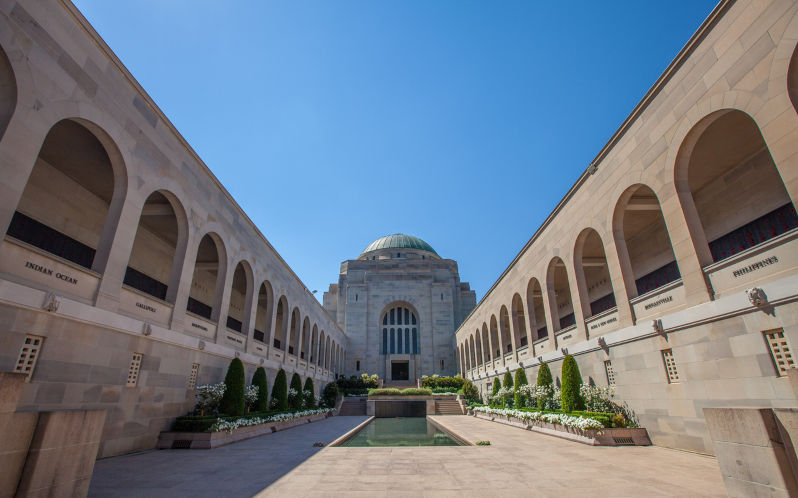Kate Grenville’s questions about our 5000 war memorials
May 6, 2025
Now that Anzac Day is done and dusted for another year, it’s time to look at Australia’s continuing war obsession from a different angle. The late distinguished historian, Ken Inglis, estimated there are between 4000 and 5000 war memorials in Australia. They are in large cities, suburbs, regional towns and villages, and on crossroads where villages once stood.
In her new book, _Unsettled_, Kate Grenville asks important questions about these memorials:
The names up in gold are places we might have difficulty finding on a map: Pozières, Tobruk, Long Tan. What I’m thinking now is, what would Australia look like if every country town didn’t only have a young man in puttees, but also a memorial for the other war, the one that happened right here at home? If the names up in gold were Myall Creek, Appin, Forrest River? After so much damage it might not be possible to list the individual names of the dead, but there’d be some way to make sure the people who’d fought for their homeland were properly remembered. (page 229)
The Australian Wars (often called the Frontier Wars) and their aftermath are present throughout Grenville’s book: the violence, the massacres, the poisoning, the herding onto reservations, the attempts to “breed out” blackness. For non-Indigenous Australians, the question, Grenville says, is not “What happened?” but “What do we do, now that we know?” (page 3).
Grenville treks over the land, from Wiseman’s Ferry to Tamworth and beyond, that her ancestors squatted on and selected from the 1820s and after. “All non-Indigenous Australians, no matter when or how they came here, benefit from the fact that this place was taken from the First Nations” (viii). Seeing a sign on a farm gate — “I’m Australian. I love this country” — she comments, “You can love something that’s been stolen. Your love for it isn’t in dispute. But it doesn’t change the fact that it was stolen (page 154).” Gazing at what was once First Nations Country, she says, “I know how little I really belong” (page 50).
Grenville also considers the language non-Indigenous Australians have used to avoid confronting our Black and White history: “gone”, the answer given to White children asking, “What happened to the Aborigines, Mum?”; “take up”, to describe how Whites acquired Black land – a euphemism for the more accurate word, “take”; “breeding out the colour”, for the motivations of Whites who took Black children from their families; “dispersing”, code for taking Blacks’ land and removing the people, perhaps with the aid of Snyder repeater rifles and poisoned flour.
There were cover-ups, too, particularly after the Myall Creek Massacre of 1838, when 30 Blacks were killed in cold blood, but, unusually, the White perpetrators were put on trial. “Seven white men were hanged, and as a result other men were more careful. The violence didn’t stop, but it went underground (page 94).” (Some Whites exposed atrocities, as David Marr’s book _Killing for Country_ shows.)
The cover-ups have helped Whites overlook the key point that Australia was founded on violent dispossession:
[I]t was our forebears who came here and did the damage … From our position at the centre of things – the ones with the power – we’ve looked out at the people we displaced and seen them as something we had to do something about: the Aboriginal issue or the Aboriginal problem (pages 28-29).
Whites, in recent generations, have been able to distinguish between not feeling guilty about what their ancestors did to Blacks and, on the other hand, recognising the need to “do something” today to deal with Blacks’ intergenerational trauma. “I didn’t do it, and it’s possible that my great-great-great-grandfather didn’t commit any of the violence. All the same, I’m part of it, because I’ve benefitted from it.” (page 18)
Back to those 5000 memorials. Surely, First Nations men, women and children dying on Country defending Country are just as worthy of commemoration at the Australian War Memorial (and all other Australian shrines and memorials) as are uniformed service people sent overseas to defend Australia? A nation commemorates what it regards as important; what it commemorates becomes important.
Grenville’s questions about how we treat the Australian Wars are particularly relevant this Anzac season:
Would there be another version of the Dawn Service on a day set aside to honour the dead, everyone coming together to walk down the main street? More reminders up in gold not to forget? And how would it feel to live in a country that could find it in itself to do that? (page 229)

